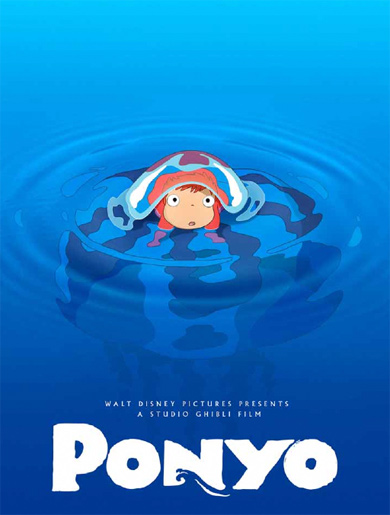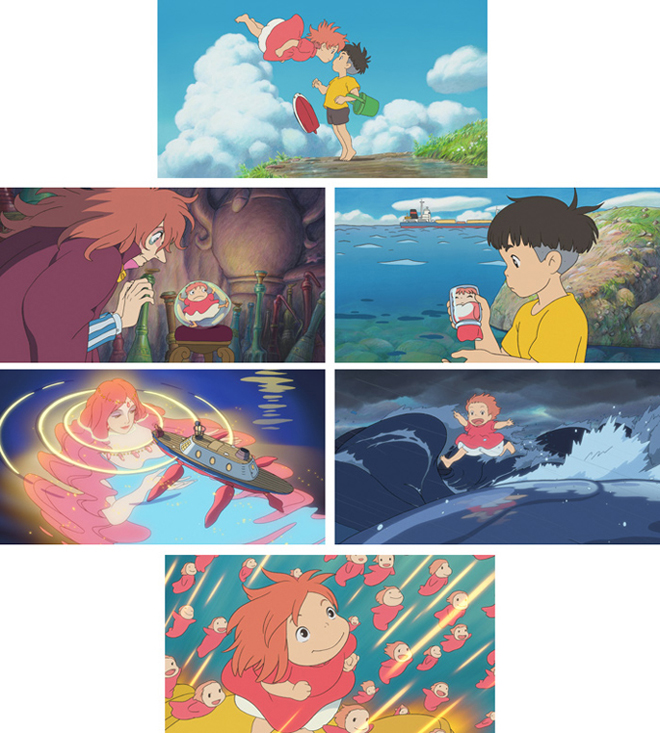
COPYRIGHTS AND RESTRICTIONS AND CONDITIONS OF THIS WEBSITE
Hayao Miyazaki's Ponyo
© 2009 Ron Barbagallo
Any discussion of Hayao Miyazaki's work needs to acknowledge that within the world of Japanese anime, Miyazaki's films are nearly unique. Many anime films use a similar visual style and their directors frequently traffic within storylines of revenge or apocalypse. While the works of Miyazaki do owe their visual lineage to the aesthetics of anime, it's Miyzaki's sensitive portraits of children, girls in particular, and his morality plays that more closely align his films with the type of narratives normally written by children's book authors Lewis Carroll, Hans Christian Andersen or J.R.R. Tolkien. Whether grounded here on Earth or heralding from some mythical place of Miyazaki's creation, Hayao Miyazaki's stories are told with the precision of a master filmmaker. As a director, his visual vocabulary and specialized storytelling are like fellow stylistic auteurs Stanley Kubrick, Tim Burton or Quentin Tarantino -- directors whose aesthetic sense is so strong and storytelling so unique that every film they make, even the small ones, are worth exploring.
As anyone who follows Miyazaki's films would know, the last several of his films have offered grand fables with elaborate stories and thoughtful character growth. A Miyazaki devotee going to see Ponyo might be surprised to find Miyazaki's film offers a smaller story (neither love story nor morality play). Its narrative is simple, literally kid's stuff. Similar to another animated film, the 1938 Walt Disney short, Wynken, Blynken and Nod, Miyazaki's Ponyo in a word is -- charming.
The film's title character Ponyo is a small aquatic girl who lives in the ocean near Tomonoura, Japan. She has many siblings and an overprotective father whose authority she likes to test. The story's other lead character Sōsuke is a small boy who lives with his mother in a house by the shore. One day, like the little mermaid in Hans Christian Andersen's story of the same name, Ponyo rebels, escapes her father's ocean world and ends up washed upon the shore where Sōsuke finds her and takes her home.
The story proceeds in ways you might expect but -- unlike the main characters in Miyazaki's films Spirited Away or Howl's Moving Castle -- Ponyo, nor her earthbound friend Sōsuke, take on the role of innocent through which we learn some greater spiritual message. Many of Miyazaki's films use the plot device of a curious little girl who learns a lesson. In Ponyo, it's more the case that the little boy Sōsuke takes on that role, however not with the same protagonist emphasis as the little girl in Miyazaki's Spirited Away or with as resounding a moral.
Ponyo, by way of its storytelling, is a simpler film with simpler goals. It's an homage to the type of films Miyazaki made earlier in his career, like Kiki's Delivery Service. It is not concerned with explaining great mysticism nor should an audience watching Ponyo expect a grander purpose beyond being swept away by its visual splendor. Having said that, the film's environmental message can be heard loud and clear and is right on target for our challenged times.
Miyazaki's films, all his films, are a spectacle in the grand way that only Hayao Miyazaki can envision; and, as such, Ponyo's water world offers wonderful colored-pencil backgrounds, epic framing and a kaleidoscope of warm rainbow tones that sit and play under cooler waves made of darkly colored fish. It is a visual music box where stylized goldfish dance. Engaging and hypnotic. Miyazaki plays to his strengths and folds you into his visuals like a master chef making an elaborate dessert. The on-screen result is instantly something to behold. Hayao Miyazaki remains the unchallenged master of wonder.
© 2009 Nibariki-GNDHDDT

Ponyo, Hayao Miyazaki's tribute to the Hans Christian Andersen story The Little Mermaid
IMAGES FROM HAYAO MIYAZAKI'S PONYO

All images are ©2009 Nibariki-GNDHDDT. ALL RIGHTS RESERVED.
The author would like to thank Sarah Baisley for her help.
This article and interview is owned by © Ron Barbagallo.
ALL RIGHTS RESERVED. You may not quote or copy from this article without written permission.
YOUR USE OF THIS WEBSITE IMPLIES YOU HAVE READ AND AGREE TO THE "COPYRIGHT AND RESTRICTIONS/TERMS AND CONDITIONS" OF THIS WEBSITE DETAILED IN THE LINK BELOW:
LEGAL COPYRIGHTS AND RESTRICTIONS / TERMS AND CONDITIONS OF USE
INSTRUCTIONS ON HOW TO QUOTE FROM THE WRITING ON THIS WEBSITE CAN BE FOUND AT THIS LINK.
PLEASE DO NOT COPY THE JPEGS IN ANY FORM OR COPY ANY LINKS TO MY HOST PROVIDER. ANY THEFTS OF ART DETECTED VIA MY HOST PROVIDER WILL BE REPORTED TO THE WALT DISNEY COMPANY, WARNER BROS. OR OTHER LICENSING DEPARTMENTS.
ARTICLES ON AESTHETICS IN ANIMATION
BY RON BARBAGALLO:
The Art of Making Pixar's Ratatouille is revealed by way of an introductory article followed by interviews with production designer Harley Jessup, director of photography/lighting Sharon Calahan and the film's writer/director Brad Bird.
Design with a Purpose, an interview with Ralph Eggleston uses production art from Wall-E to illustrate the production design of Pixar's cautionary tale of a robot on a futuristic Earth.
Shedding Light on the Little Matchgirl traces the path director Roger Allers and the Disney Studio took in adapting the Hans Christian Andersen story to animation.
The Destiny of Dalí's Destino, in 1946, Walt Disney invited Salvador Dalí to create an animated short based upon his surrealist art. This writing illustrates how this short got started and tells the story of the film's aesthetic.
A Blade Of Grass is a tour through the aesthetics of 2D background painting at the Disney Studio from 1928 through 1942.
Lorenzo, director / production designer Mike Gabriel created a visual tour de force in this Academy Award® nominated Disney short. This article chronicles how the short was made and includes an interview with Mike Gabriel.
Tim Burton's Corpse Bride, an interview with Graham G. Maiden's narrates the process involved with taking Tim Burton's concept art and translating Tim's sketches and paintings into fully articulated stop motion puppets.
Wallace & Gromit: The Curse Of The Were-Rabbit, in an interview exclusive to this web site, Nick Park speaks about his influences, on how he uses drawing to tell a story and tells us what it was like to bring Wallace and Gromit to the big screen.
For a complete list of PUBLISHED WORK AND WRITINGS by Ron Barbagallo,
click on the link above and scroll down.
INDEX OF SERVICES
The Ethical Method of Repair
The Attention is in the Details
the Lost and FOUND series
RON BARBAGALLO: